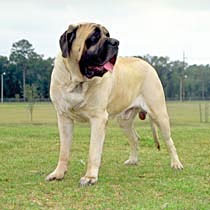|
The Canine Chronicles Directory
Mastiff

Mastiffs are one of the heaviest breeds. A male Mastiff can exceed 200 pounds! They
are very massive, muscular and powerful. Mastiffs have short coats with the colors
being brindle, fawn, apricot, silver or tiger. They also have black mask-like markings
around the eye and nose areas. The muzzle is short and the sturdy head is large.
The small, dark eyes are hazel in color and the ears are also dark. The teeth should
have a slight undershot or a scissor-like bite. The neck is slightly arched and
broadens as it merges into the shoulders. The rounded chest should be deep with
a reasonable tuck up and the topline should be straight. The heavy-boned forelegs
should be wide set and straight. The strong hindlegs should be wide set and parallel
from the back. The large feet should be round and compact with well-arched toes.
The high set tail should taper to the tip.
|
|
Temperament
|
Mastiffs are good-natured, loyal, calm, brave, gentle, and docile. They are wonderful
around children; however, they are not recommended for infants because of their
size. Disposition in the breed varies depending on the lineage. They can either
be friendly or aloof when around strangers. They are a perfect guard dog, holding
intruders off rather than attacking them. They can be possessive of their owners,
their home and even the car. Mastiffs do not tend to wander off, staying close to
their family and property. This breed tends to drool, wheeze and snore loudly.
|
|
Height, Weight
|
Male Height: 30" ; Weight: up to 160 lbs.
Female Height: 27" ; Weight: up to 150 lbs.
|
|
Health Problems
|
This breed is prone to hip dysplasia and bloat. Feed two or three smaller meals
a day instead of one large meal. Also prone to gastric torsion, ectropion, vaginal
hyperplasia, elbow dysplasia and PRA.
|
|
Living Conditions
|
This breed is okay for apartment living as long as they get sufficient exercise.
They do better with an average-sized yard.
|
|
Exercise
|
Mastiffs can tend to be a bit lazy so exercise will keep them fitter. This breed
should always be on a lead in public.
|
|
Life Expectancy
|
About 10-12 years
|
|
Grooming
|
The short coat of this breed is easy to care for. Brush with a firm brush or wipe
with a cloth. Bathe when necessary. This breed is an average shedder.
|
|
Origin
|
Known to be in existence over 4000 years ago, the Mastiff was treasured by the Babylonians,
depicted in Egyptian monuments, and included in Persian, Roman, and British literature.
The breed was brought to the British Isles by Phoenician traders in the 6th century
BC during the reign of Julius Caesar. In the 13th century, explorer Marco Polo visited
the Chinese Emperor Kubla Kahn and documented 5000 mastiffs at the court. Throughout
the centuries this breed has been used as gladiators, war dogs, hunting and for
blood sports such as bull, bear and dog combat. They were eventually used as cart
pullers, sheep guardians, personal bodyguards and companions. The Mastiff was brought
to the United States on the Mayflower. They adapted well, encouraging other colonists
to import the breed. By World War II, the Mastiff was bred throughout the United
States and Canada; however, they were nearly extinct in England. English citizens
believed it was unpatriotic to keep a dog that ate the same amount of food as a
soldier. In the last few years, with the help of American and Canadian imports,
the breed is slowly being reestablished in England. They are recognized by the AKC
and the UKC.
|
|
Group
|
AKC Working, UKC Guardian Dog
|